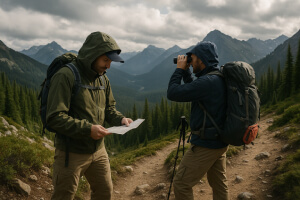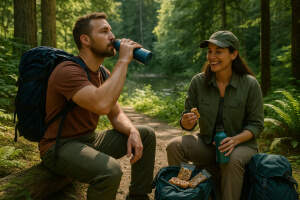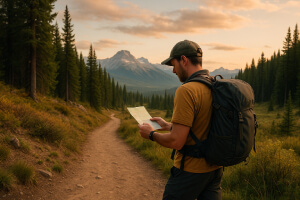Hiking across British Columbia offers sights to behold, through forested trails to mountain vistas and coastal paths. Yet nature, for all its beauty, comes with its share of perils. That balance is maintained when you are prepared and follow safety precautions: Thrust in it makes outdoor adventures fun and safe. This guide will expose you to some safety tips that beginner and advanced hikers should know-how to prepare, the gear to use, proper trail etiquette, and emergencies.
The main concern has to be being safe so that confidence is built and the joy is magnified from tackling a short urban trail to a backcountry hike that could take hours.
Why Safety Matters on the Trails

Hiking is generally safe; however, hazards are increased by factors such as trail difficulty, remoteness, and unanticipated weather changes. Typical hazards include accidents, encounters with wildlife, and getting lost, which can all be made minimal with efficient planning. When safety is ensured, one can then place priority on enjoying the whole experience, appreciating the beauty around, and being assured of a firm step forward into the next adventure.
Aside from preventing any untoward incidences, safety also consists of skill-building, being aware, and self-confidence. When one is able to identify a risk factor and take precautions, the experience along BC trails can be carried out with full respect for the environment.
Planning Ahead: Research and Preparation
Preparation is the basis of safe hiking. Check trail information, conditions, and have a fair idea of your route before leaving.
Know Your Trail
- Trail Difficulty: Read the ratings and distances of the trail. Try shorter and easier trails before going on to longer or more difficult ones.
- Terrain and Elevation: Get to know the terrain of your trail and, depending on steep climbs, rocky paths, or river crossings, pick those trails that match your ability.
- Season Conditions: Some trails are best done in particular seasons. Snow and ice or even heavy showers can render a dangerous path.
Check the Weather
BC weather changes promptly. Checking the weather forecast for rain, wind, or extreme temperatures is always a good idea. Dress in layers and pack appropriate weather gear, including a waterproof jacket and protection from the sun.
Inform Someone
Always let a friend or family member know where you will hike, including the route, time you will begin and finish it, and your expected time of return. This simple act may prove to be invaluable during an emergency.
Essential Hiking Gear for Safety
Being comfortable and safe implies using the correct gear. Safety starts with the equipment that fits your trail and environment.
Footwear
Hiking shoes or boots will give the hiker good stability, grip, and support. Getting the right fit for these shoes is equally important so you don’t face blisters or any form of ankle injuries.
Clothing
Layering is paramount. The base layer should wick away moisture; the middle layer should provide insulation; and the outer layer should be waterproof. Do not wear cotton as it holds moisture.
Navigation Tools
Trail maps, compasses, or GPS devices are advisable. Even though trails can be quite well marked, the navigation tools come in handy in unfamiliar areas
On the Trail: Staying Safe While Hiking
Safety in hiking comes with knowing, pacing, and respecting the environment.
Stick to Marked Trails
Stepping off the marked trails is very risky in getting lost and can cause damage to some sensitive ecosystems. Keep to signs, trail markers, and regulations.
Pace Yourself
Walk at your own pace, especially if you are a first-time hiker. Take breaks whenever necessary; keep sipping water; and keep a continual read on your energy levels. Accident may occur when you push yourself harder than it is necessary.
Wildlife Awareness
BC has its share of bears, cougars, and other beasts. Learn about them in the area where you are going to hike and follow these best practices:
- Make some noise to announce your approach.
- Keep a distance and never feed the animals.
- In bear country, do carry bear spray and learn how to use it.
Emergency Preparedness
An emergency can hurry itself into being, regardless of all preparation. The ability to respond to an emergency can save lives.
Basic First Aid
Have in your bag a small first-aid kit that covers the basics: bandages, antiseptic wipes, blister treatment, and pain relievers, among others. Know how to treat common minor injuries such as cuts, sprains, and insect bites.
Communication
Always bring a fully-charged phone; however, please note that reception is not guaranteed in the remote.
Weather-Related Emergencies
Expect sudden changes in weather. Take cover if a storm erupts. Avoid being up on exposed ridges in front of lightning. Watch for symptoms of hypothermia related to freezing cold rains.
Getting Lost
If lost:
- Remain calm and halt all movement if you are unsure of your whereabouts.
- If you can, try to retrace your steps with your map, compass, or GPS.
- Make noise or signal: whistle, wave a brightly colored cloth.
- Be visible and conserve energy as you wait for assistance.
Hydration and Nutrition

Proper hydration and nutrition are essential to your safety. In contrast, losing water or sustenance can lead to a diminution in judgment or physical capability.
- Regularly drink water, even if you are not yet thirsty.
- Carry snacks that are lightweight and easy to eat: nuts, granola bars, dried fruit.
- Plan longer hikes and bring extra food for unexpected delays.
Hiking with Others

While solo hiking happens, for beginners it is safer with an accompanying party. Hiking with a partner or a group increases the sense of safety, support in emergencies, and fun in the experience.
If hiking alone:
- Let someone know where you will go.
- Carry more safety gear and take extra caution.
- Stay to populated or traveled trails.
Safety First
Exploring the great outdoors in B. C. is an amazing way to be active and to see landscapes in their myriad forms. Ensuring safety makes every hike fun and reduces accidents. Preparedness, well-equipped, alert on the trail, and ready to face emergencies allow hikers of all ages to enjoy BC trails with confidence. Safety is the ability to prepare, to be aware of one’s surroundings-or the environment-and to be respectful to one’s own limitations.
Walk BC will be giving you some resources and tips which will hopefully enable both neophyte and seasoned hikers in optimizing their out-of-door experiences safely and securely. Remember: safe and secure hiking experiences require great planning, right gear, and consideration on one’s part.
